
Regular readers might have noticed the disappearance of articles relating to the Personal Data Protection Commission’s decisions lately. However, as news of the “largest” data breach in Singapore came out, I decided to look into this area again.
My lack of interest paralleled the changing environment, which allowed me to keep up-to-date on them:
- The PDPC removed their RSS feed for the latest updates;
- I am not allowed to monitor their website manually; and
- The PDPC started issuing shorter summaries of their decisions, which makes their work more opaque and less interesting.
Looking at this area again, I wanted to see whether the insights I gleaned from my earlier data project might hold and what would still be relevant going forward.
Data Science with Judgement Data – My PDPC Decisions JourneyAn interesting experiment to apply what I learnt in Data Science to the area of law. Love.Law.Robots.Houfu
Love.Law.Robots.Houfu
Something big struck, well, actually not much.
 Photo by Francesca Saraco / Unsplash
Photo by Francesca Saraco / Unsplash
The respondent in the case that had attracted media attention is Reddoorz, which operates a hotel booking platform in the budget hotel space. The cause of the breach is as sad as it is unremarkable — they had left the keys to their production database in the code of a disused but still available version of their mobile app. Using those keys, bad actors probably exfiltrated the data. This is yet another example of how lazy practices in developing apps can translate to real-world harm. They even missed the breach when they tried to perform some pen tests because it was old.
PDPC | Breach of the Protection Obligation by CommeasureBreach of the Protection Obligation by Commeasure PDPC Logo
PDPC Logo Read the PDPC’s enforcement decision here.
Read the PDPC’s enforcement decision here.
The data breach is the “largest” because it involved nearly 6 million customers. Given that the resident population in Singapore is roughly 5.5 million, this probably includes people from around our region.
The PDPC penalised the respondent with a $74,000 fine. This roughly works out to be about 1 cent per person. Even though this is the “largest” data breach handled under the PDPA, the PDPC did not use its full power to issue a penalty of up to $1 million. Under the latest amendments, which have yet to take effect, the potential might of the PDPC can be even greater than that.
The decision states that the PDPC took into account the COVID-19 situation and its impact on the hospitality industry in reducing the penalty amount. It would have been helpful to know how much this factor had reduced the penalty to have an accurate view of it.
In any case, this is consistent with several PDPC decisions. Using the PDPC’s website’s filters, only three decisions doled out more than $75,000 in penalties, and a further 4 doled out more than $50,000. This is among more than 100 decisions with a financial penalty. Even among the rare few cases, only 1 case exercised more than 25% of the current limit of the penalty. The following case only amounts to $120,000 (a high profile health-related case, too!).
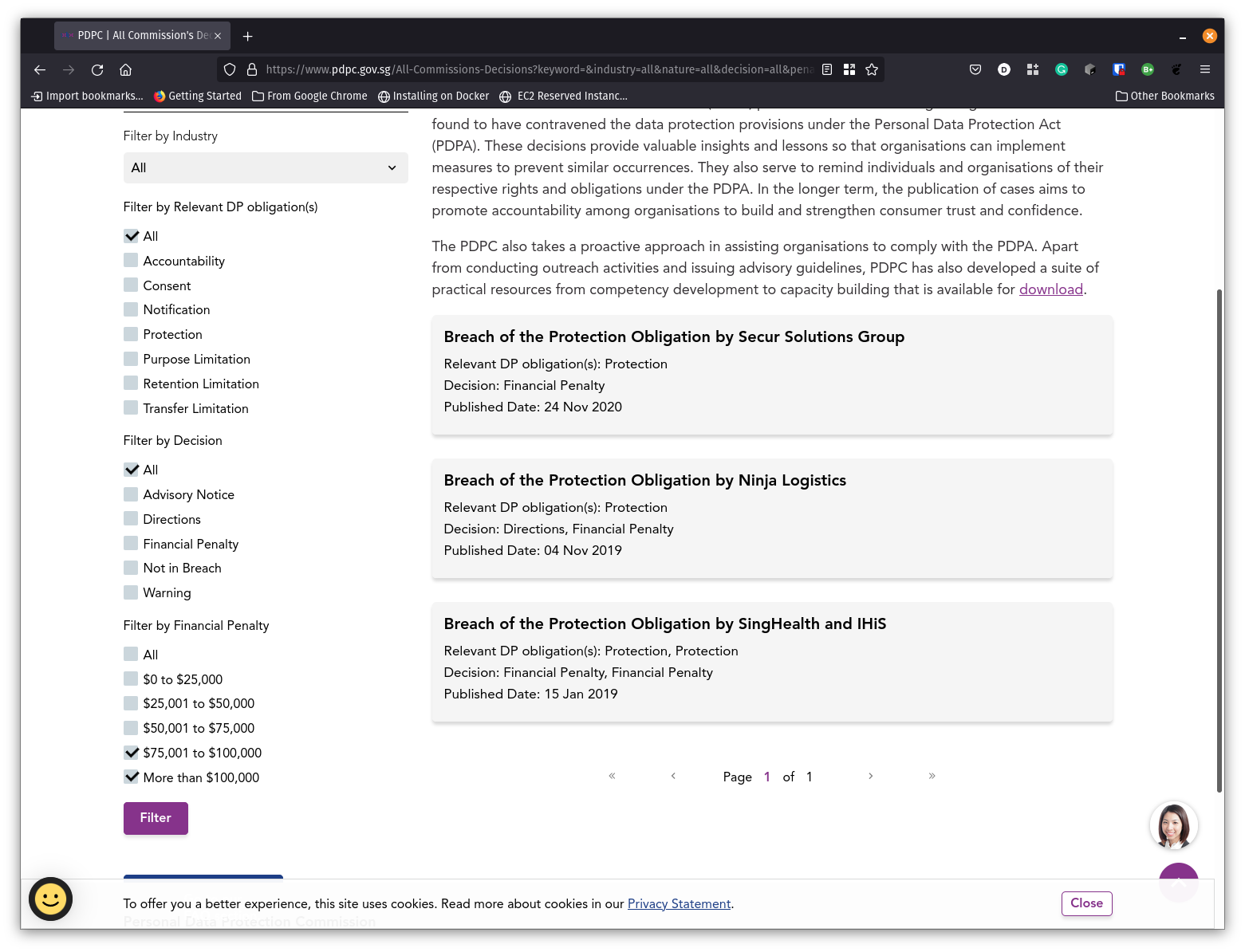 The top of the financial penalty list (As of November 2021). Take note of the financial penalty filters at the bottom left corner.
The top of the financial penalty list (As of November 2021). Take note of the financial penalty filters at the bottom left corner.
This suggests that the penalties are, in practice, quite limited. What would it take for the PDPC to penalise an offender? Probably not the number of records breached. Maybe public disquiet?
In a world without data breaches
 Photo by Parker Burchfield / Unsplash
Photo by Parker Burchfield / Unsplash
While the media focuses on financial penalties, I am not a big fan of them.
While doling out “meaningful” penalties strikes a balance between compliance with the law and business interests, there are limits to this approach. As mentioned above, dealing with a risk of $5,000 fines may not be sufficient for a company to hire a team of specialists or even a professional Data Protection Officer. If a company’s best strategy is not to get caught for a penalty, this does not promote compliance with the law at all.
Unfortunately, we don’t live in a world without data breaches. The decisions, including those mentioned above, are filled with human errors. Waiting to get caught for such mistakes is not a responsible strategy. Luckily, the PDPA doesn’t require the organisation to provide bulletproof security measures, only reasonable ones. Then, the crux is figuring out what the PDPC thinks is enough to be reasonable.
So while all these data protection decisions and financial penalties are interesting in showing how others get it wrong, the real gem for the data protection professional in Singapore is finding someone who got it right.
And here’s the gem: Giordano. Now I am sorry I haven’t bought a shirt from them in decades.
There was a data breach, and the suspect was compromised credentials. However, the perpetrator did not get far:
- The organisation deployed various endpoint solutions
- The organisation implemented real-time system monitoring of web traffic abnormalities
- Data was regularly and automatically backed up and encrypted anyway
Kudos to the IT and data protection team!
Compared to other “Not in Breach” decisions, this decision is the only one I know to directly link to one of the many guides made by the PDPC for organisations. “How to Guard Against Common Types of Data Breaches” makes a headline appearance in the Summary when introducing the reasonable measures that Giordano implemented.
The close reference to the guides signals that organisations following them can have a better chance of being in the “No Breach” category.
An approach that promotes best practices is arguably more beneficial to society than one that penalises others for making a mistake. Reasonable industry practices must include encrypting essential data and other recommendations from the PDPC. It would need leaders like Giordano, an otherwise ordinary clothing apparel store in many shopping malls, to make a difference.
A call from the undertaking
 Photo by Nicola Fioravanti / Unsplash
Photo by Nicola Fioravanti / Unsplash
The final case in this post isn’t found in the regular enforcement decisions section of the PDPC’s website — undertakings.
If you view a penalty as recognising a failure of data protection and no breach as an indicator of its success, the undertaking is that weird creature in between. It rewards organisations that have the data protection system for taking the initiative to settle with the PDPC early but recognises that there are still gaps in its implementation.
I was excited about undertakings and called them the “teeth of the accountability principle”. However, I haven’t found much substance in my excitement, and the parallel with US anti-corruption practices appears unfounded.
Between February 2021, when the undertaking procedure was given legislative force, and November 2021, 10 organisations spanning different industries went through this procedure. In the meantime, the PDPC delivered 21 decisions with a financial penalty, direction or warning. I reckon roughly 30% is a good indicator that organisations use this procedure when they can.
My beef is that very little information is provided on these undertakings, which appears even shorter than the summaries of enforcement decisions. With very little information, it isn’t clear why these organisations get undertakings rather than penalties.
Take the instant case in November as an example. Do they have superior data protection structures in their organisations? (The organisation didn’t have any and had to undertake to implement something.) Are they all Data Protection Trust Mark organisations? (Answer: No.) Are they minor breaches? (On the surface, I can’t tell. 2,771 users were affected in this case.)
My hunch is that (like the Guide to Active Enforcement says) these organisations voluntarily notified the PDPC with a remediation plan that the PDPC could accept. This is not as easy as it sounds, as you might probably engage lawyers and other professionals to navigate your way to that remediation plan.
With very little media attention and even a separate section away from the good and the ugly on the PDPC’s website, the undertaking is likely to be practically the best way for organisations to deal with the consequences of a data breach. Whether the balance goes too far in shielding organisations from them remains to be seen.
Conclusion
Having peeked back at this area, I am still not sure I like what I find. There was a time when there was excitement about data protection in Singapore, and becoming a professional was seen as a viable place to find employment. It would be fascinating to see how much this industry develops. If it does or it doesn’t, I believe that the actions and the approach of the PDPC to organisations with data breaches would be a fundamental cause.
Until there is information on how many data protection professionals there are in Singapore and what they are doing, I don’t think you will find many more articles in this area on this blog.
#Privacy #PersonalDataProtectionCommission #PersonalDataProtectionAct #Penalties #Undertakings #Benchmarking #DataBreach #DataProtectionOfficer #Enforcement #Law ##PDPAAmendment2020 #PDPC-Decisions #Singapore #Decisions
 Love.Law.Robots. – A blog by Ang Hou Fu
Love.Law.Robots. – A blog by Ang Hou Fu
- Discuss... this Post
- If you found this post useful, or like my work, a tip is always appreciated:

- Follow this blog on the Fediverse [Enter the blog's address in Mastodon's search accounts function]
- Contact me:




 Photo by
Photo by  The top of the financial penalty list (As of November 2021). Take note of the financial penalty filters at the bottom left corner.
The top of the financial penalty list (As of November 2021). Take note of the financial penalty filters at the bottom left corner. Photo by
Photo by  Photo by
Photo by 
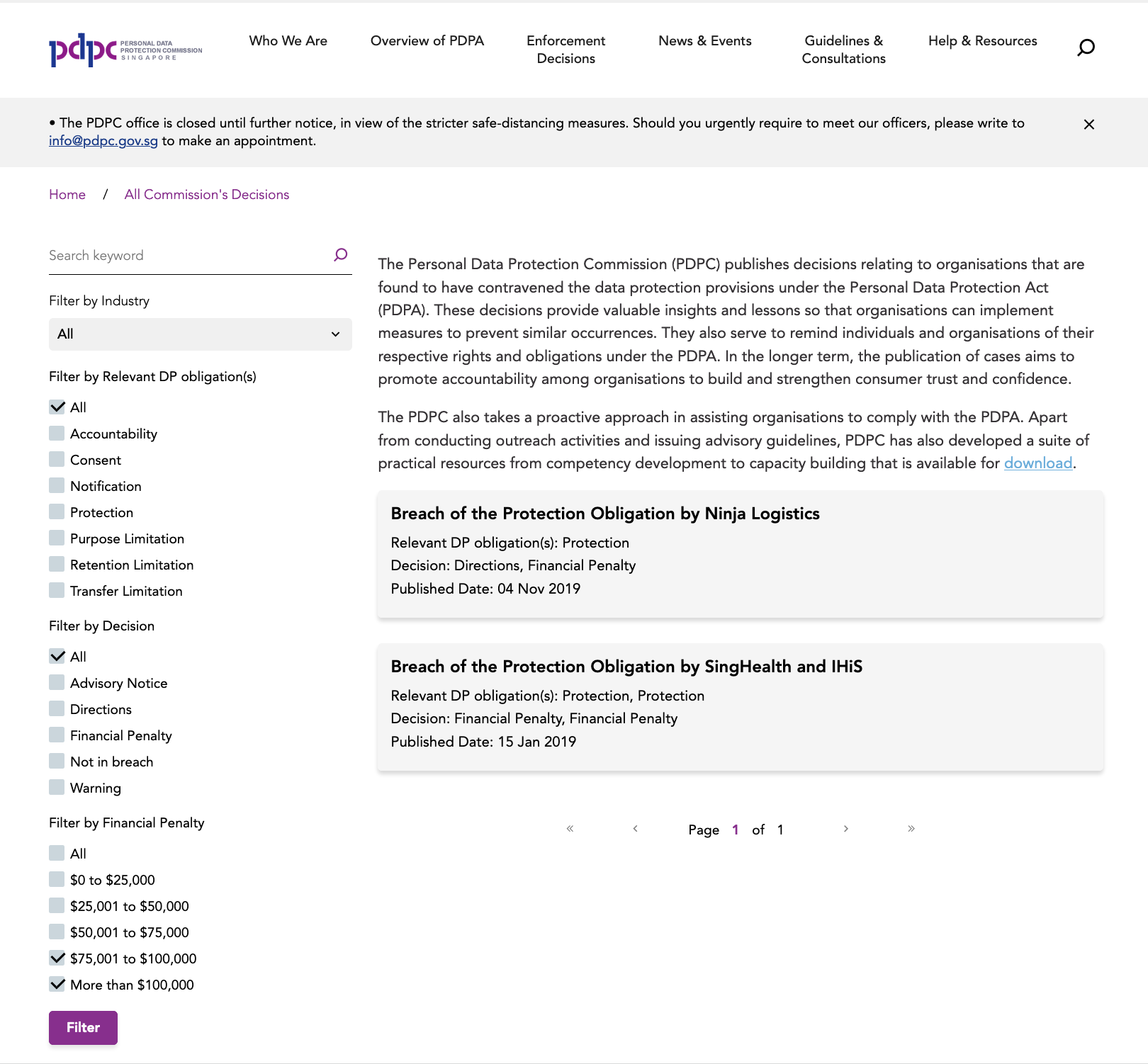 Screen capture of filters of PDPC decisions with financial penalties of more than $75000. (As of October 2020)
Screen capture of filters of PDPC decisions with financial penalties of more than $75000. (As of October 2020)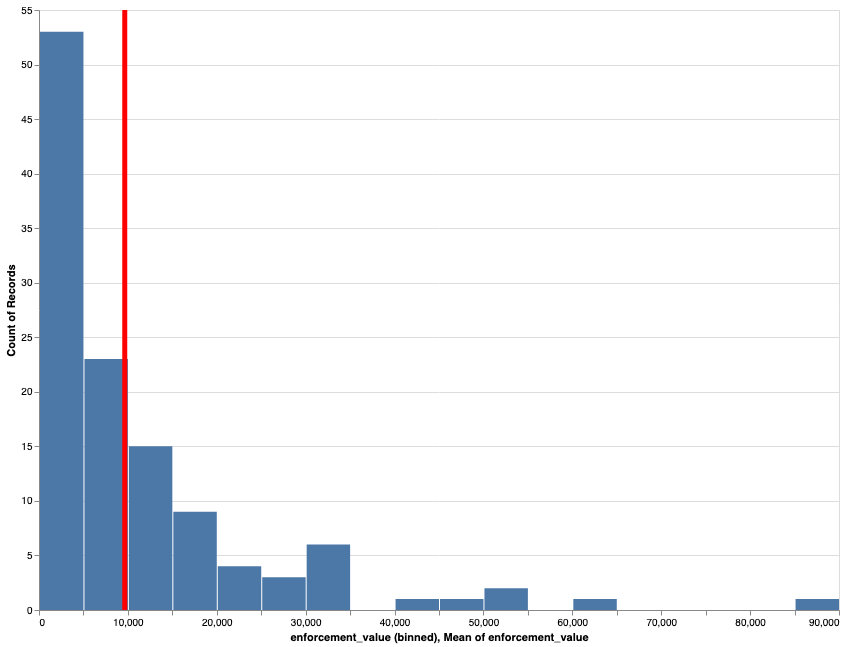 Histogram of the number of cases binned on enforcement value.
Histogram of the number of cases binned on enforcement value.





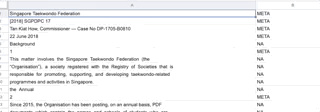 Classification of lines for training
Classification of lines for training

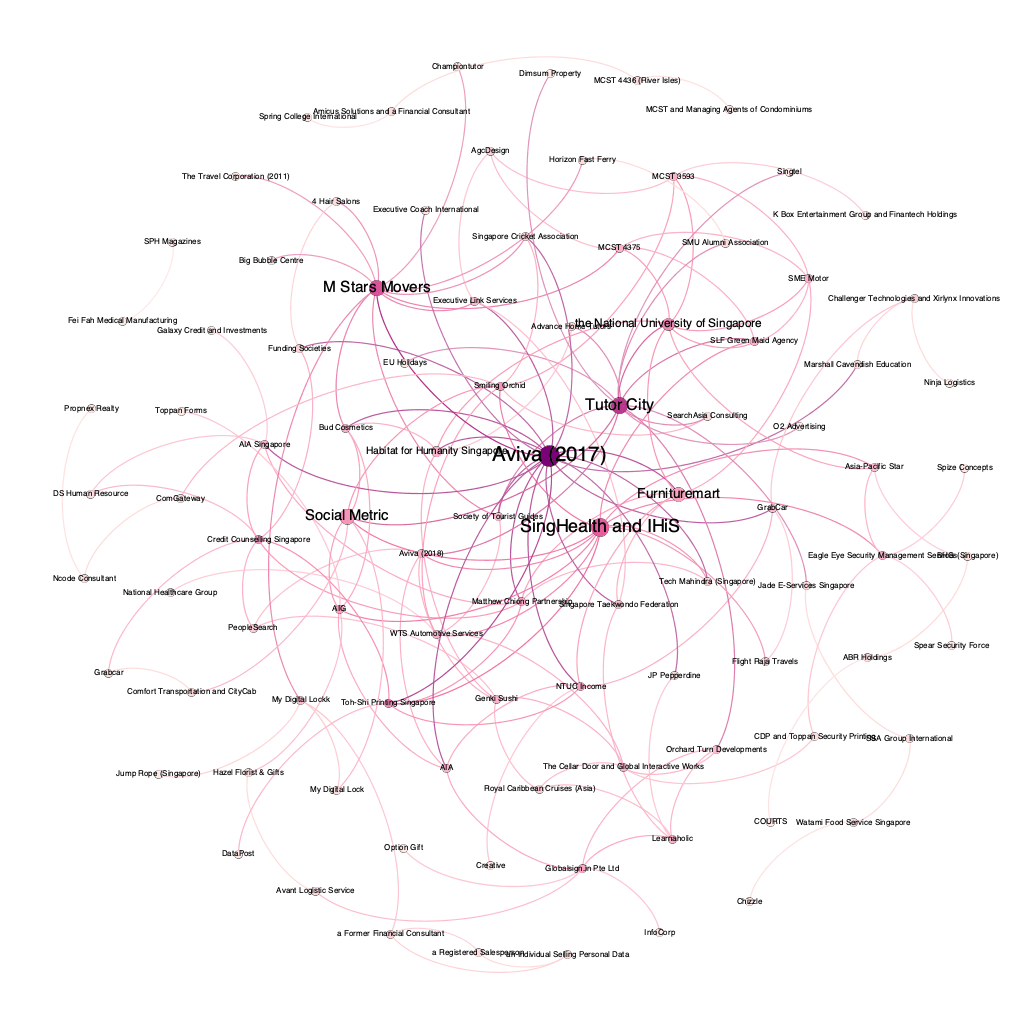 I guess this is the
I guess this is the 